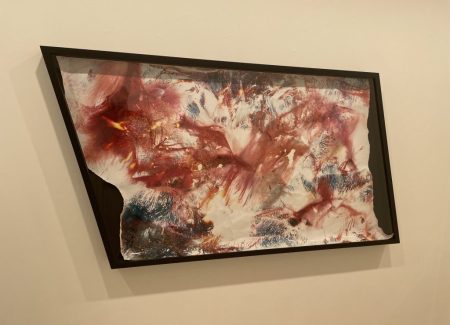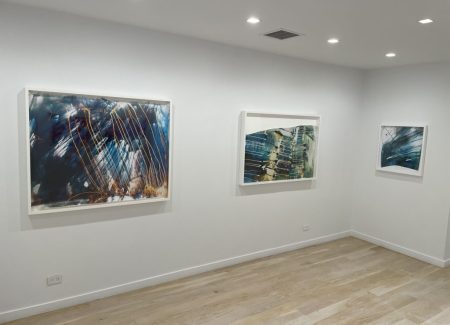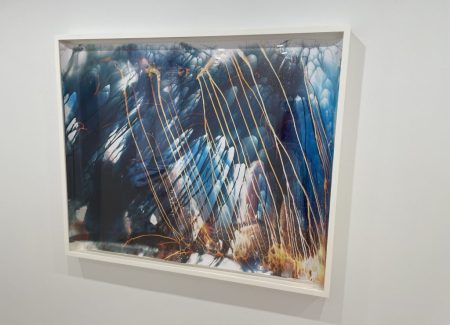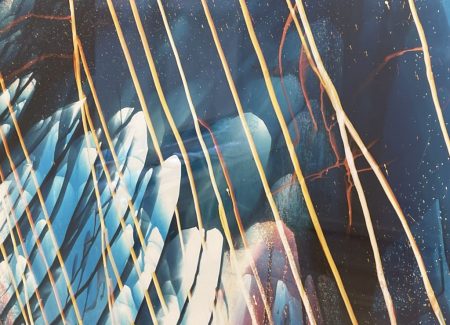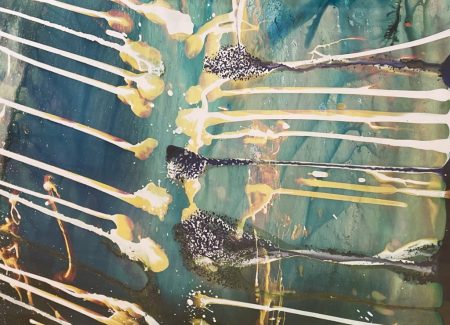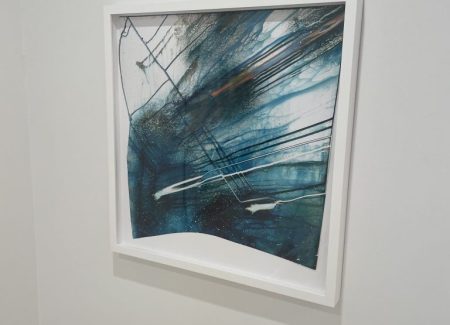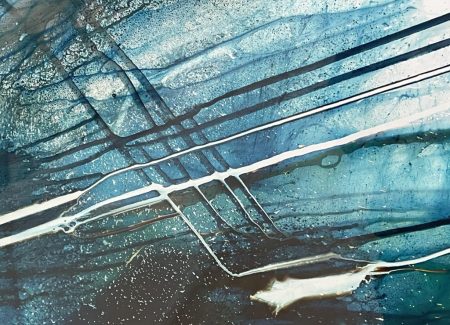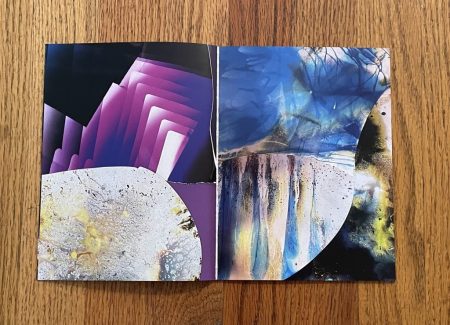JTF (just the facts): A total of 7 color works, framed in white/black and unmatted, and hung against white walls in the main gallery space, the elevator entry, and the office area on the third floor. All of the works are chemical treatment on RA-4 paper, made in 2014, 2014/2021, or 2015/2022. Physical sizes range from roughly 24×23 to 92×30 inches (or the reverse) and all the works are unique.
A thin photobook titled Book of Details 2022 has been self-published by the artist to coincide with the exhibition. (Cover and spread shots below.)
Comments/Context: For many artists, the isolation of the pandemic years forced an unintended return to simplified first principles. Without access to studios, materials, external locations, or support teams, many turned inward, looking closely at themselves and rediscovering the pivot points in their artistic processes and practices.
For Mariah Robertson, her pandemic journey began in 2020 by pulling out several hundred older works (made over the previous decade) and moving them around in her studio. As the works came out from storage, piled atop one another, and overlapped in groups, she started to see new compositional possibilities within the relationships of the layered fragments. And in a few cases, she documented some of the serendipitous aggregations with snapshots. Encouraged by her studio assistant, Robertson continued to look more closely at these inadvertent photographic reworkings, triggering a new path of potential artistic investigation.
Robertson has been actively exploring the limits of expressive darkroom-based experimentation for more than a decade now, with each of her gallery shows over the years offering an evolution of gestures, colors, patterns, and motifs, all made within the confines of the darkness. While her shows of new work in 2017 (reviewed here) and then back a year to 2016 (reviewed here) found Robertson exploring the staccato repetition of harder edged forms and the layering of bright saturated color, in the years just prior, she had been working more loosely with chemical washes, drips, and fluids, leading to the splashier effects found in her 2013 show (reviewed here).
This aesthetic backstory is relevant because the current 2022 show largely reaches back to rediscovered works originally made in 2014 and 2015, in that more wet and washed style, and uses them as raw material. Several of the finished works on view come unaltered from those years, with compositions enlivened by streams of fluid that seem to drift and fall across the surface. In four works rooted in hues of blue and green, these lines (in white, black, and other colors) finger and interlace, dripping across each other like thin lava flows, or falling away from central spines like insistently layered or offset stripes; when these flows are pointed (or rotated) “upward”, they seem to have even more explosive energy, like rivulets of colored rain blasting across a windshield.
Robertson has consistently used long rolls of paper as her preferred format, either letting various darkroom improvisations connect in one undulating billow, or slicing individual pieces off the roll, creating single frames with roughly scissored or torn edges. In the context of re-imagining older works in shifting new configurations of multiple pieces, these edges take on important properties, almost like compositional tools. In “100 & 123”, Robertson places two works in dialogue with each other, one a cloudy wash of pink with a dark cosmic sides, the other a blast of orange with similar black undertones. Both have rough edges, so when the two are laid together, the two shapes overlap unevenly, with areas of white showing underneath. The resulting pair feels connected but distinct, perhaps like two moments in time, or two related ideas coalescing in different ways.
The collage-like compositions in Robertson’s small photobook Book of Details 2022 take these ideas much further, in a few cases incorporating half a dozen or more fragments into the arrangements. Robertson’s darkroom activities are no longer the endpoint, but the beginning; improvisational marks and chance gestures are now reoriented and arranged with deliberate intention, with the sliced paper edges taking on their own life as breakpoints between ideas.
The most important byproduct of this collaging is that the resulting works no longer have one point from which the energy of the composition radiates; given the nature of Robertson’s chemical washes, it’s simply physics that leads the water to flow from one direction to another. In the new layered works, that single direction gets scrambled, often into a kaleidoscope of competing perspectives and orientations, with watery chemicals and drips wandering in opposing directions. Robertson also gets a second chance at controlling the mark making, as she can now crop certain sections and arrange them in ways that make the lines (and fogs, and splashes, and flares) move in the ways she wants. In the darkroom, she was essentially pre-visualizing what she hoped to achieve and then going ahead in the dark; now she is post-visualizing, seeing the results and then editing and re-compositing the fragments as physical prints.
The strongest of these new layered works use both the movement of the chemicals and the edges of the paper with risk-taking abandon, creating juxtapositions that fight with each other, and yet find their way to some kind of uneasy equilibrium. The works that take echoes of stripes and repeat (or reorient) them are too easy; Robertson is at her best on the knife edge of control, where the compositions threaten to blow apart with the force of opposing magnets. Four or five explosions mixed into a shifting pile is more her speed, with echoes of drips, slashes across the pictures, and the lines of the paper edges linking the aggregate images into something approaching visual coherence.
Given that these works are remixes of the past, they aren’t likely a stopping point where Robertson will linger for long. But perhaps the artistic learnings that come from the layering process will lead her elsewhere, or can be incorporated more durably into her next body of work. As an opportunistic pandemic diversion, these aggregations seem to have sparked some new thinking about downstream physicality and recollaging fragments into more complex forms. As such, this show feels like an intermediate step, where a selection of initial artistic tests have proven surprisingly promising, but the refined synthesis and evolution of a new aesthetic framework has not yet fully taken place.
Collector’s POV: The works in this show are priced between $9000 and $24000, based on size. Robertson’s work has little secondary market history at this point, so gallery retail likely remains the best option for those collectors interested in following up.
